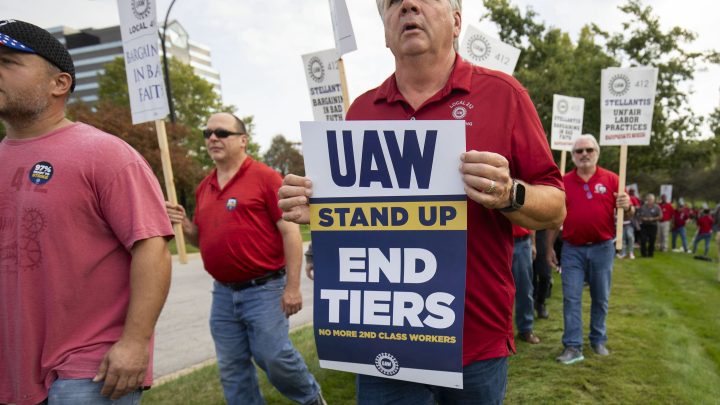
Automakers aren’t the only manufacturers that rely on temporary workers
Automakers aren’t the only manufacturers that rely on temporary workers

The UAW’s strike against the big Detroit automakers is about to enter its second week. One big bone of contention in the negotiations is the carmakers’ use of temporary workers. The companies say temps give them flexibility, and the union wants temps to automatically get permanent status after 90 days.
The auto industry isn’t alone in relying on temps. In fact, they’re common throughout the manufacturing sector.
Across the U.S. labor force, about 1 of every 50 workers is temporary. But on the factory line, it’s 1 in 10, according to analysis by Susan Houseman, an economist with the Upjohn Institute for Employment Research.
“The use of temps in manufacturing is quite prevalent,” she said. “And it’s been growing over time.”
One reason manufacturers turn to temporary employees is it lets them scale their workforce up and down as needed.
“Take autos — you’ve got new models coming on every year,” said Houseman. “And so there’s a ramping up of production when a new model comes.”
Temporary status also lets companies screen workers before giving them permanent jobs. And sometimes, they use it to reduce labor costs.
The UAW says under its current contract, temps can earn half as much as permanent employees.
There are downsides for employers too, pointed out Erin Hatton, author of the book “The Temp Economy.”
“Temps tend to be less trained for the job, less invested in that particular workplace, because they don’t know if they’re going to be there tomorrow,” Hatton said.
That ambivalence can be contagious.
Wharton’s Peter Cappelli found that when more temps were introduced into a workplace, the job performance of permanent employees fell.
“Temp work is often thought of, understandably, as kind of second-class work,” he said. “It lowers your own view of the value of your job, the more temp workers are working with you.”
Cappelli said employers have to consider whether temp employees will save them money or cost them money by dragging down productivity.
There’s a lot happening in the world. Through it all, Marketplace is here for you.
You rely on Marketplace to break down the world’s events and tell you how it affects you in a fact-based, approachable way. We rely on your financial support to keep making that possible.
Your donation today powers the independent journalism that you rely on. For just $5/month, you can help sustain Marketplace so we can keep reporting on the things that matter to you.











